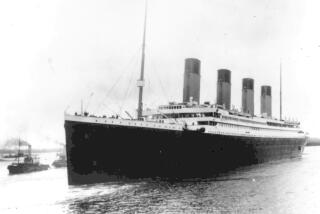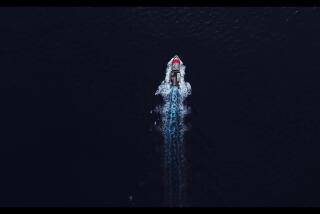Oceanographer Ballard: His Discoveries Connect Science With History
Robert D. Ballard headed up the discovery of two fabled sunken ships, the Titanic in 1985 and, just last month, the World War II German battleship Bismarck. In both cases, poignant reminders of human frailty persist on the dark, cold ocean floor, he says, lingering testaments to the dead, dragged far beyond air and light by plummeting hulks of steel and iron.
Shoes.
Pairs and pairs of shoes resting on the sea floor as if their owners had just stepped out of them.
“People say, ‘What was it like to go to the Titanic, particularly out in the debris area, the stern section where everyone died?’ ” Ballard recalls of the ocean liner that sank to a depth of 12,000 feet in the North Atlantic in 1912, killing 1,500 of the 2,200 passengers and crew. “There are pairs of shoes all over there where people actually came to rest on the bottom of the ocean. Their shoes are still there. Shoes all over the Bismarck, boots all over the place. Animals won’t eat processed leather. They eat the body and the clothes but they won’t eat the leather.”
Oceanographer Ballard, in Los Angeles to announce that he will host a television series about underwater explorations and other scientific ventures, is somewhere in the middle of a long explanation about why he pursues the sunken past with such avidity. Partly, he concedes, it’s for the sensations that only discovery can provide.
The Moment of Discovery
“I think the thrill of exploration is to see something, to be the first to set eyes on something that has never been seen before,” he says. “The first time I saw the Titanic, wow! There it was, this monstrous ship just came out of the gloom and there it was.”
For Ballard, the moment of discovery is intellectually kinetic--an instant when he connects palpably with history. “The best experience that I can give that’s sort of an analogy is like going to Custer’s Last Stand,” he says. “To go and stand where Custer stood and imagine, you know, bad day to be in the cavalry. That’s the sense, it’s your hallowed grounds. You sense Crazy Horse there . . . and you just realize the hopelessness of the situation. Well, when you’re out at the Titanic and all of a sudden it happened right here . It’s no longer abstract.”
Unknown territory, scientific and historic, has been Ballard’s country for more than two decades, perhaps even as far back as his childhood in Southern California, when he was smitten by accounts of African exploration and became captivated by the Pacific Ocean. Now, four years after the discovery of the Titanic catapulted him from mere well-known scientist to global fame, the 47-year-old seems to be in the throes of another transformation. This time around he apparently is eager to shape both the future and the past with the technology that he developed in more than a decade of underwater exploration.
Furthermore, he plans to use his new tools as the new host of National Geographic Explorer, a weekly two-hour program produced by National Geographic and Turner Broadcasting System Inc. It is the kind of popularizing of science that Ballard has been criticized for in the past by his peers. But Ballard says he sees his metamorphosis into TV personality as an educational mission that may help convince children that science is a “contact sport.”
Discussing the search for the Bismarck, Ballard obviously savors the contact with history and science.
Because the Bismarck was engaged in a running battle hundreds of miles from land when it sank, neither the British nor the Germans were able--or much interested--in keeping precise records of their locations. So Ballard’s expedition had to search about 150 square miles of ocean floor, initially with sonar and then with remote control, computerized robot sensors and cameras controlled from a surface ship before locating the wreck June 8. (This kind of exploration isn’t cheap, Ballard notes, joking that “we had 100,000 pounds of equipment and 10 vans and six robots and a partridge in a pear tree.”)
“You have to understand that the Bismarck battle was waged in a Force 8 sea--50-knot winds, 15-foot waves--(with) overcast and no celestial navigation,” Ballard says.
The search for the Bismarck--which, like the Titanic, sank on its maiden voyage--was further complicated by the nature of the Atlantic Ocean. The battleship was in “16,000 feet of water and it was in a mountain range,” Ballard says, not without enthusiasm. “It was in an awful place and it was in the northern latitudes, up at 48 degrees North latitude, which is not a nice stretch of ocean--ever, even in the summer.”
Despite the difficulties, Ballard was drawn to the wreck because, like the Titanic, it is one of the most famous lost chunks of history to litter the ocean floor. “I do it because of the challenge to do it,” he says. “But I’m also interested in the fact that this ship is well preserved. . . . There is probably more history preserved in the deep oceans of the world than in all the museums of the world.”
Although it has lost its gun turrets and was hit by numerous shells and torpedoes, the Bismarck still has touches of freshness, Ballard adds, citing the “huge painted swastikas” on the ship’s bow and stern.
In its day, the 50,000-ton Bismarck, with heavy armor, eight 15-inch guns capable of firing one-ton shells 24 miles and high-performance diesel engines, was one of the most powerful warships afloat. And briefly it proved to be just that. Slipping out of its home port of Danzig (now Gdynia) on May 18, 1941 to attack Allied convoys, the Bismarck soon had much of the British Royal Navy looking for it. At the time England faced a victorious Germany alone and was dependent on convoys from America for most of its food and war material. Discovered by two British heavy cruisers on May 23, the Bismarck was engaged the next day by two other British warships. From a distance of 25,000 yards, the Bismarck’s huge shells hit the Hood, starting a fire in an ammunition locker. Within minutes the Hood exploded, killing all but three of the ship’s 1,400 crew members. The Prince of Wales was also damaged.
Of the Bismarck, “the British were lucky to get it to the bottom,” Ballard claims. In the climactic battle, a “freak hit” by a torpedo launched from a vintage World War I biplane knocked out the Bismarck’s steering, forcing the crippled battleship to “wait for the British to come and get it.” Of course, the British came and the Bismarck was sunk in the Atlantic about 600 miles west of France.
Since the discovery of the Bismarck, Ballard says there has been curiosity about what actually caused the ship to sink--British firepower or scuttling by her own crew. But Ballard believes the evidence makes the point moot. The British warships had orders to sink the Bismarck, not capture it, and the Germans were under orders not to let the pride of their fleet be taken as a war prize, he says.
At 10 a.m. on May 27, the captain of the Bismarck ordered his crew to open the seacocks on his disabled ship, thus flooding the hull, Ballard recounts. About 10:30 a.m., the Bismarck was hit by three torpedoes from the British cruiser Dorsetshire and sank three minutes later.
Bismarck’s Survivors
“So it was on its way down and the torpedoes helped--but it was on its way down,” Ballard says. “If they hadn’t opened the seacocks, I’m convinced the British would have sat there and plunked torpedoes into it until it sank. So it’s sort of academic who sank it.” Only about 100 of the Bismarck’s crew survived. Nearly 2,300 perished, including several hundred who were swimming in the water after their ship disappeared.
It is that moment that seems to galvanize Ballard.
“When the Bismarck sank, approximately 800 living souls went into the water and were alive after the ship went under,” he says, leaning forward in his chair. “And the Dorsetshire came in and began picking up survivors and then someone thought they saw a periscope and they took off and they left 700 people in the water alive. . . . Can you imagine the awfulness, the hopelessness, the despair of the sailor who’s just had a ship blown out from underneath him? He’s paddling and freezing to death in this water and salvation is right there and he’s grabbing hold of the hull and the ship takes off.”
Ballard has said he will not reveal the exact location of the Bismarck except to German authorities. As a ship of war, the battleship belongs to Germany, he says, although there might be some debate about which half of that divided country would have the more legitimate claim.
As with the Titanic, Ballard says he strongly believes that such relatively recent wrecks should be left undisturbed, memorials to those who perished. As for wrecks from the dim reaches of the past, Ballard argues that they should be explored only by qualified archeologists intent on broadening historical knowledge. In fact, he still becomes visibly angry that private expeditions to the Titanic took some artifacts from the wreck.
Developed Deep-Sea Robots
But Ballard seems to be chiefly an enthusiast, not a critic. In particular he is a proponent of machines, especially robots. Ballard has headed up the development of a system of deep-sea unmanned robots--called the Argo-Jason system. Equipped with cameras and other sensing devices, the robots are now capable of plumbing the world’s deep waters faster and more safely than the tiny, slow, manned submarines that previously were the cutting edge of ocean research and exploration, he says.
While an unmanned robot named Jason Jr. was used in a 1986 expedition to the Titanic, it was only within the last few months that the leap was made “to fully robotic exploration,” Ballard says, meaning that robots can now be directed from a surface ship rather than from a manned submarine via a control cable.
It’s a relief that he and others won’t have to spend five or more hours per day “commuting” to the ocean floor, which averages 12,000 feet in depth, he says. Even though he has spent a lot of time in cramped research submarines and probably will spend more, Ballard is miffed by the inefficiency of the “romantic little guys,” referring to the small submarines.
He explains: “. . . you’re spending five hours a day freezing to death in this little sphere. Our average dive time on the Titanic was three hours a day. Three hours out of 24 and you’ve got 50 people and you’ve got one guy looking out of a window.”
More Interest in Science
Ballard has been talking about the potential of this technology for years. But recent advances have made him more convinced than ever that the concept of “telepresence” will revolutionize not only undersea exploration but the way many people “travel.” More important, he sees the technology as capable of rekindling interest in science among American schoolchildren.
“We’re now reaching a point in technology, in imaging devices both acoustic and visual, fiber optic transmission links, digital enhancement, computer manipulation, robotics etc, etc. to simulate presence,” he says in a gee-whiz way. “In fact many of us in the technology believe it will become a pervasive way of people living their lives. In other words, ultimately you won’t travel that much. You’ll travel in a telepresence way. We can have this conversation half a world apart and you’ll sense my presence, I’ll sense yours. . . . The idea of the Argo-Jason system is to put you in a room and convince you you’re in a submarine looking out a bunch of windows” that are in fact video monitors displaying scenes picked up by robot-mounted cameras.
Ballard, whose professional base is the Woods Hole Oceanographic Institution on Massachusetts’ Cape Cod, is such a believer in the concept of telepresence that he’s already using it to change the way he lives. He recently built a house near Montana’s Glacier National Park in which he is installing a satellite antenna so that he can bounce his image and voice into space and back to Earth for professional meetings and conversations with people far, far away. His goal is “to create a place where I don’t feel professionally inconvenienced by living in Montana.”
How much time he actually will spend in northern Montana is an open question, though, given the demands of the Explorer television series.
With the series, including a program on the Bismarck to be broadcast in late October, Ballard asserts that he can do his bit to instill a respect for the past and take millions on magical mystery tours of the kingdoms under the sea.
”. . . 70% of the planet’s under water. We’ve seen less than .1% of 1%. I mean we know more about the mountain ranges on Mars than the mountain ranges of our own planet,” he says.
The Vast Unknown
It is this sense of the vast unknown here on Earth that he wants to communicate.
“To me the concept of an explorer has been somewhat diminished,” he says. “People now retrace Hannibal’s route in a Winnebago or they walk backwards to the North Pole. It’s sort of become a Guinness Book of World Records type of thing.”
And he says he wants to do his part to protect good old people-friendly dry land too.
“It’s very important right now to realize that the Earth is in jeopardy and we’re the first generation that can kill it and we’re killing it,” he says, leaving the battles of World War II far behind. “. . . This baloney about living in space is baloney. You send everyone else out there and give me Montana. I have no desire to live underwater. I’ve seen the place.”
BISMARCK
Type: German battleship
Length: 823 feet
Displacement: 52,000 tons
Date Sunk: May 27, l941
Lives Lost: 2,100
Depth: 16,000 feet
Date Found: June 8, l989
Type: British super luxury liner
Length: 882 feet
Displacement: 45,000
Date Sunk: April 14, l912
Lives Lost: 1,500
Depth: 12,000
Date Found: Sept.1, l985






